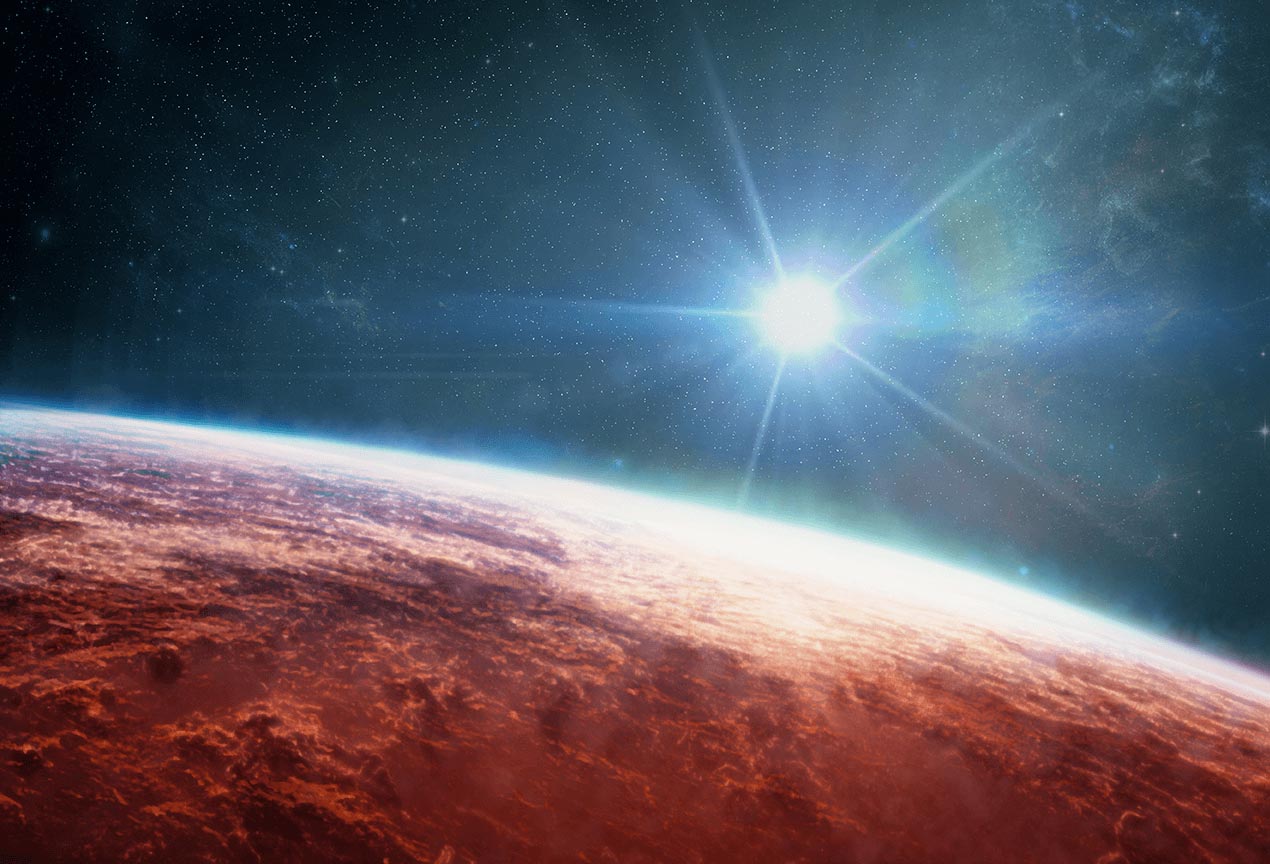Webb Reveals a “Hot Saturn” Exoplanet Atmosphere

This illustration depicts the exoplanet WASP-39 b and its star. Credit: Melissa Weiss/Center for Astrophysics | Harvard & Smithsonian
New Webb Space Telescope observations of WASP-39 b reveal a never-before-seen molecule in the atmosphere of a planet — sulfur dioxide — among other details.
The telescope’s array of highly sensitive instruments was trained on the atmosphere of WASP-39 b, a “hot exoplanet that is about as massive as Saturn and orbits closely to a star such that it has high surface-atmosphere temperatures. Although Webb and other space telescopes, including Hubble and Spitzer, have previously revealed isolated ingredients of this broiling planet’s atmosphere, the new readings provide a full menu of atoms, molecules, and even signs of active chemistry and clouds.
“The clarity of the signals from a number of different molecules in the data is remarkable,” says Mercedes López-Morales, an astronomer at the Center for Astrophysics | Harvard & Smithsonian and one of the scientists who contributed to the new results.
“We had predicted that we were going to see many of those signals, but still, when I first saw the data, I was in awe,” López-Morales adds.
The latest data also give a hint of how these clouds in exoplanets might look up close: broken up rather than a single, uniform blanket over the planet.
The findings bode well for the capability of Webb to conduct the broad range of investigations on exoplanets — planets around other stars — scientists hoped for. That includes probing the atmospheres of smaller, rocky planets like those in the TRAPPIST-1 system.
“We observed the 
Webb Space Telescope observations of WASP-39 b reveal sulfur dioxide in the atmosphere. This is the first time this has been detected in the atmosphere of an exoplanet. Credit: Melissa Weiss/Center for Astrophysics | Harvard & Smithsonian
The suite of discoveries is detailed in a set of five new submitted scientific papers, available on the preprint server arXiv. Among the unprecedented revelations is the first detection in an exoplanet atmosphere of sulfur dioxide, a molecule produced from chemical reactions triggered by high-energy light from the planet’s parent star. On Earth, the protective ozone layer in the upper atmosphere is created in a similar way.
“The surprising detection of sulfur dioxide finally confirms that photochemistry shapes the climate of hot Saturns,’” says Diana Powell, a 
The atmospheric composition of the hot gas giant exoplanet WASP-39 b has been revealed by NASA’s James Webb Space Telescope. This graphic shows four transmission spectra from three of Webb’s instruments operated in four instrument modes. At upper left, data from NIRISS shows fingerprints of potassium (K), water (H2O), and carbon monoxide (CO). At upper right, data from NIRCam shows a prominent water signature. At lower left, data from NIRSpec indicates water, sulfur dioxide (SO2), carbon dioxide (CO2), and carbon monoxide (CO). At lower right, additional NIRSpec data reveals all of these molecules as well as sodium (Na). Credit: NASA, ESA, CSA, Joseph Olmsted (STScI)
At an estimated temperature of 1,600 degrees
Capturing such a broad spectrum of WASP-39 b’s atmosphere was a scientific tour de force, as an international team numbering in the hundreds independently analyzed data from four of Webb’s finely calibrated instrument modes. They then made detailed inter-comparisons of their findings, yielding yet more scientifically nuanced results.
Webb views the universe in infrared light, on the red end of the light spectrum beyond what human eyes can see; that allows the telescope to pick up chemical fingerprints that can’t be detected in visible light.
Each of the three instruments even has some version of the “IR” of infrared in its name: NIRSpec, NIRCam, and NIRISS.
To see light from WASP-39 b, Webb tracked the planet as it passed in front of its star, allowing some of the star’s light to filter through the planet’s atmosphere. Different types of chemicals in the atmosphere absorb different colors of the starlight spectrum, so the colors that are missing tell astronomers which molecules are present.
By so precisely parsing an exoplanet atmosphere, the Webb instruments performed well beyond scientists’ expectations — and promise a new phase of exploration among the broad variety of exoplanets in the galaxy.
López-Morales says, “I am looking forward to seeing what we find in the atmospheres of small, terrestrial planets.”
For more on this topic, see NASA’s Webb Reveals an Exoplanet Unlike Any in Our Solar System.
Reference: “Direct Evidence of…

